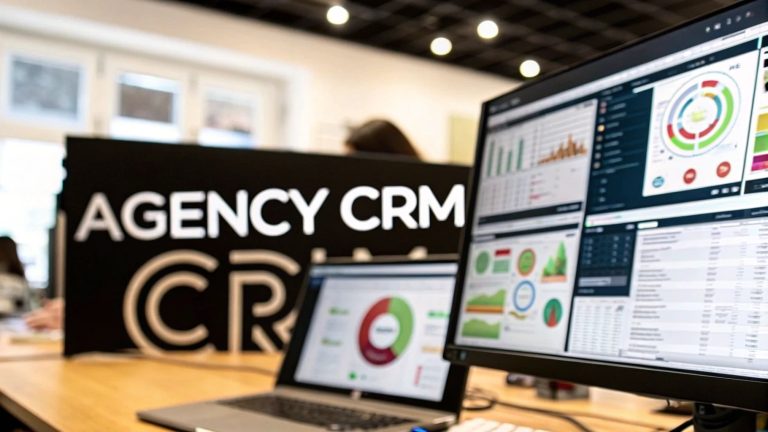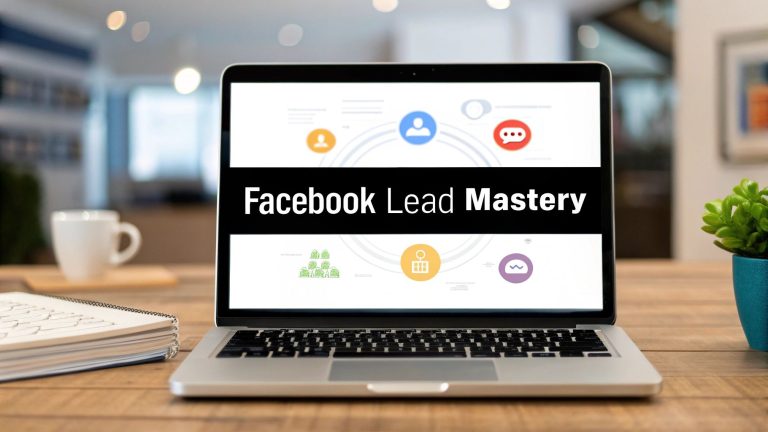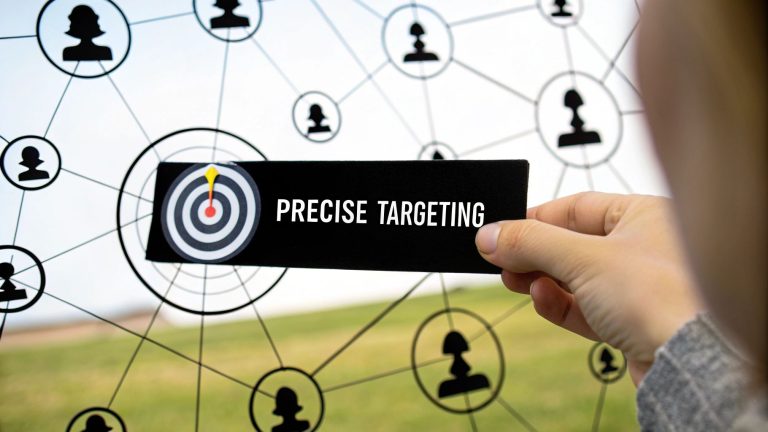What Is Lead Scoring? Boost Sales with Proven Strategies
So, you've got leads coming in. Great! But are they all created equal? Absolutely not. Some are just kicking the tires, while others are ready to pull out their credit cards. The million-dollar question is: how do you tell the difference?
That’s where lead scoring comes in.
What Is Lead Scoring and Why It Matters
Think of lead scoring as your sales team's ultimate priority filter. It’s a system for assigning points to each lead you get, automatically ranking them based on who they are and what they do. This tells you exactly how ready they are to have a conversation with your sales team.
Imagine you're a detective staring at a board full of clues. You can't chase down every single one, so you focus on the "hot" ones first. Lead scoring is how you identify those hot leads in your sales pipeline. It's the secret sauce for separating the curious browsers from the serious buyers.

Without a system like this, sales reps are flying blind. They end up treating every lead the same, wasting precious hours on prospects who aren't a good fit or just aren't ready to buy. That leads to longer sales cycles, frustrated reps, and a whole lot of missed opportunities.
Bringing Order to Your Sales Process
Lead scoring injects a dose of data-driven sanity into your sales process. By giving points for specific actions (like visiting your pricing page) or demographics (like their job title), you create a clear hierarchy. This isn't just about organization; it's about solving real business problems:
- Better Sales and Marketing Alignment: Finally, both teams can agree on what a "good lead" actually looks like. Marketing knows exactly what to aim for, and sales gets leads they're genuinely excited to call.
- Sky-High Sales Efficiency: Your sales team can stop guessing and start focusing their energy only on the leads with the highest scores. They'll know with confidence that these are the people most likely to convert.
- Lightning-Fast Response Times: High-scoring leads can trigger instant notifications for your reps. This allows them to follow up in minutes, right when the lead's interest is at its absolute peak.
Simply put, lead scoring is a core part of any modern lead qualification process, helping you pinpoint and prioritize your most valuable prospects.
Lead scoring turns your lead management from a shot in the dark into a strategic, well-oiled machine. It guarantees your sales team's time is spent where it delivers the biggest payoff.
And the results speak for themselves. Businesses that implement lead scoring models see up to a 77% jump in lead conversion rates. Even better, they cut the time wasted on dead-end leads by more than half. That’s a massive win.
To give you a clearer picture, here’s a quick rundown of the core ideas behind lead scoring.
Key Lead Scoring Concepts at a Glance
This table breaks down the fundamental building blocks of any effective lead scoring system.
| Concept | Description | Example |
|---|---|---|
| Lead Attributes | The characteristics of a lead. This includes both demographic data (who they are) and firmographic data (details about their company). | Job Title (e.g., "VP of Marketing"), Company Size (e.g., "100-500 employees"), Industry (e.g., "SaaS"). |
| Lead Behavior | The actions a lead takes that signal their interest and engagement with your brand. | Opening an email, visiting the pricing page, downloading a whitepaper, requesting a demo. |
| Point Values | The numerical score assigned to each attribute or behavior. Higher values are given to stronger buying signals. | +10 points for a "Director" title, +15 points for a demo request, -5 points for an "intern" title. |
| Score Threshold | The total score a lead must reach to be considered a "Marketing Qualified Lead" (MQL) or "Sales Qualified Lead" (SQL). | A lead with a score of 75+ is automatically routed to the sales team for immediate follow-up. |
| Negative Scoring | The practice of subtracting points for actions or attributes that indicate a poor fit or lack of interest. | -10 points for visiting the careers page, -20 points for being a student, -5 points for unsubscribing from emails. |
Understanding these components is the first step to building a system that consistently delivers high-quality, sales-ready leads right to your team's doorstep.
The Building Blocks of a Strong Lead Scoring Model
So, what actually goes into a lead scoring model? Think of it like a detective building a case. You need two types of evidence to get the full picture: the hard facts about a person and clues from their behavior.
One tells you who they are, and the other tells you what they're doing. You need both to know if a lead is worth pursuing.
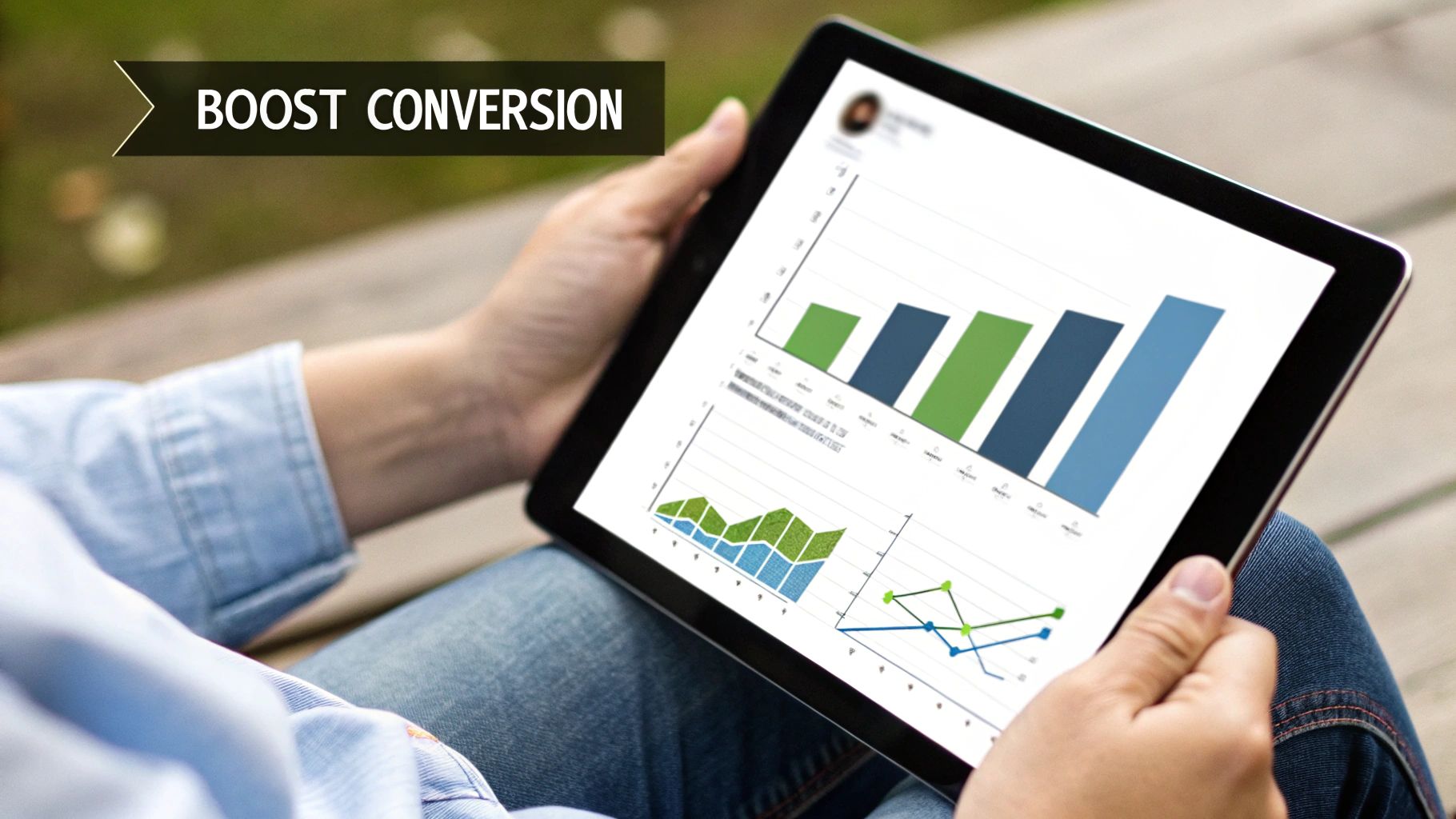
This is a great visual breakdown. It shows how different data points—both who the person is (demographics) and what they've done (behavioral)—are given point values that add up to a final score. Combining these two elements is the secret to getting an accurate read on a lead's potential.
Explicit Data: The Hard Facts
Explicit data is the information a lead gives you straight up. It’s the stuff they type into your forms when they download a guide, sign up for a webinar, or request a demo.
Think of it as their business card. It gives you the clear, factual details needed to see if they match your Ideal Customer Profile (ICP). The closer the match, the higher you score them.
- Job Title: A "Director of Marketing" is probably a much better fit than an "Intern." You might give the director +10 points and the intern -5 points.
- Company Size: If you sell enterprise software, a lead from a company with 500+ employees is way more interesting than one from a five-person startup.
- Industry: A lead from the "SaaS" world could be a perfect match, while someone from "Non-Profit" might not be the right fit at all.
This data tells you if you should even be talking to this person in the first place.
Implicit Data: The Behavioral Clues
While explicit data tells you who a lead is, implicit data reveals their intent. These are the digital breadcrumbs they leave behind as they interact with your brand—all tracked by your website analytics, email platform, or CRM.
This is where you get to gauge a lead's actual interest level. Big actions get big points.
Implicit scoring is about listening to what leads do, not just what they say. A lead who visits your pricing page three times in one week is sending a much stronger buying signal than someone who only reads one blog post.
Here’s how you might score these behaviors:
- Website Engagement: Visiting high-value pages like your pricing or case studies could earn +15 points. A quick stop on the homepage? Maybe just +2.
- Email Interaction: If they’re consistently opening your emails and clicking links, that’s active interest. Give them +5 points for each click.
- Content Consumption: Downloading an advanced, bottom-of-funnel guide is a big deal (+10 points), while reading a top-of-funnel blog post is a smaller signal.
For a deeper dive into how you can assign these points across different scenarios, check out our guide on practical lead scoring examples.
Negative Scoring: The Red Flags
Just as you add points for good signs, you have to subtract them for red flags. This is called negative scoring, and it's your filter for weeding out the wrong people—competitors, job seekers, or just plain poor-fit leads.
This keeps your sales team from wasting precious time on dead ends.
Actions that should cost them points:
- Visiting your "Careers" page (-10 points). They're looking for a job, not a solution.
- Unsubscribing from your email list (-25 points). That's a clear "not interested."
- Using a personal email address like Gmail or Yahoo instead of a business one (-5 points).
By mixing explicit facts, implicit behaviors, and negative red flags, your model starts to paint a truly complete picture of every single lead. It’s an intelligent system that ensures your team is always talking to the people most likely to become happy customers.
How to Build Your First Lead Scoring Framework
Alright, let's roll up our sleeves and build your first lead scoring model. It might sound like a huge, complicated project, but it really just boils down to a simple idea: defining what a great lead looks like for your business and then assigning points based on that definition.
But here’s the most important rule: this is a team sport. This isn't something marketing cooks up in a silo. The absolute best, most effective lead scoring frameworks are built when marketing and sales work together from day one.
Think about it—your sales team is in the trenches every single day, talking to leads. They know exactly which job titles actually have buying power, which company sizes are a waste of time, and which online behaviors signal a person is ready to talk. If you ignore their insights, you'll build a perfect-on-paper model that sends them "qualified" leads they immediately toss in the trash.
Define Your Ideal Customer Profile Together
First things first: sit down with your sales team and get brutally honest about your Ideal Customer Profile (ICP). This isn't a vague persona; it's a super-detailed description of the exact type of company you want as a customer. And don't guess—base this on the data from your best, happiest, most profitable clients right now.
Get together and ask some critical questions to hammer this out:
- What industries are our best customers in?
- What's their typical company size or annual revenue?
- Which specific job titles are always involved when a deal closes?
- Are there certain cities, states, or countries that convert way better than others?
Answering these questions gives everyone a shared definition of a "good lead" before a single point is even assigned. This alignment is everything.
A well-defined ICP is the North Star for your entire lead scoring system. Every point you assign should directly reflect how closely a new lead matches this ideal profile.
Identify Key Scoring Attributes and Actions
Once you know who you're looking for, you can start pinpointing the specific data points and actions that matter. We'll break these down into the two main buckets we talked about: explicit data (the hard facts) and implicit data (their behavior).
Work with sales to make a list for both. For explicit data, you might decide a "Director" title is worth a solid +10 points, but a "Manager" only gets +5. For implicit actions, someone requesting a demo is a massive buying signal, easily worth +25 points. On the flip side, a single blog view is a small sign of interest, maybe just +3 points.
And don't forget negative scoring! Someone visiting your careers page is probably looking for a job, not your product. Slap a -15 points on that action to weed them out.
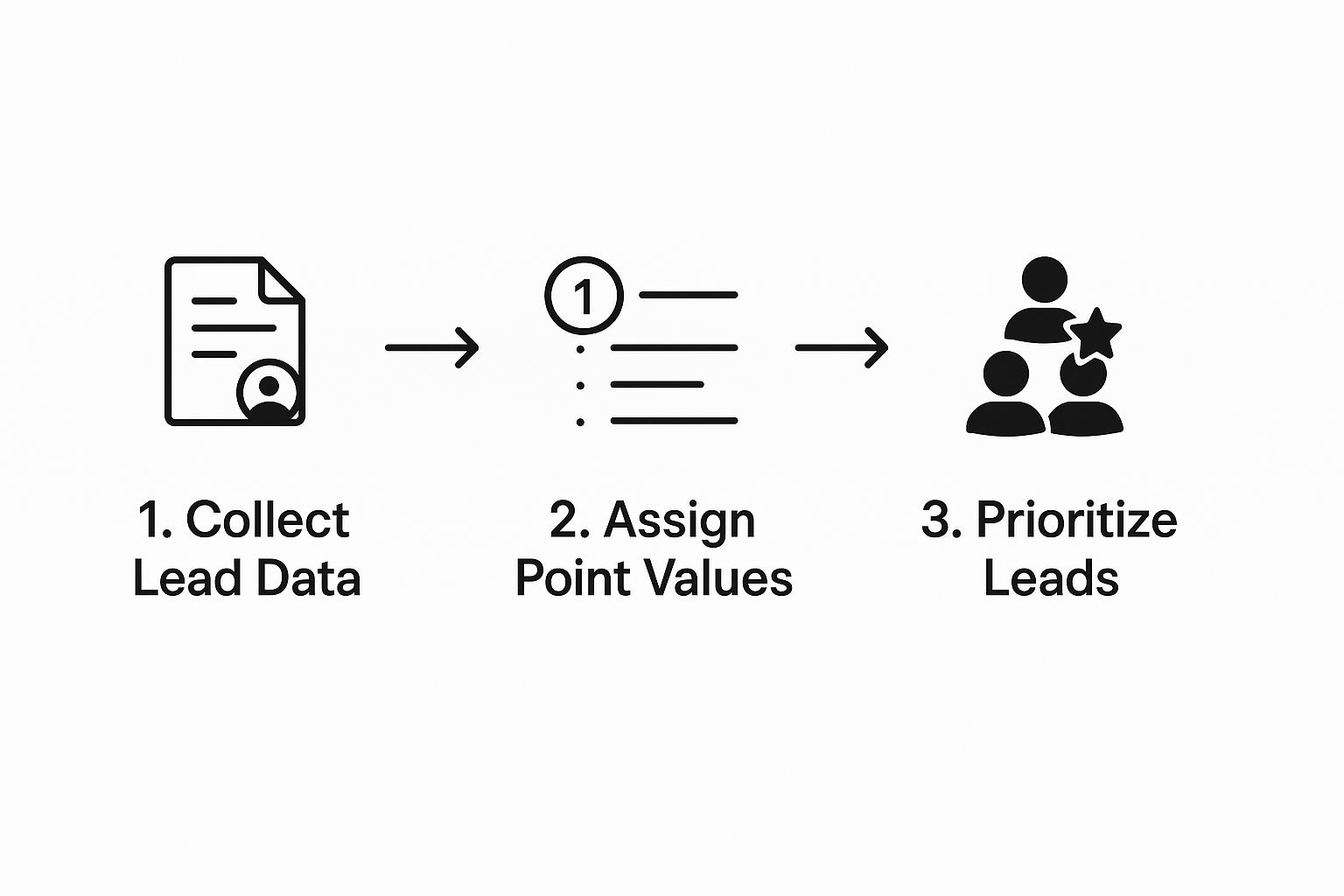
This simple flow really highlights how effective lead management starts with strong data collection—the foundation of any good lead generation strategy.
Set Your Score Thresholds
Okay, you've assigned points to all the key attributes and actions. The final piece of the puzzle is setting the score thresholds. This is the magic number that tells your system, "Hey, this lead is hot! Send it over to the sales team, stat!"
A simple tiered approach works great to start:
- Engaged Lead (25+ points): They're on the radar. Keep them in a marketing nurture campaign with targeted content.
- Marketing Qualified Lead (MQL) (50+ points): They're showing strong interest and fit the ICP. They're getting warm.
- Sales Qualified Lead (SQL) (75+ points): Ding, ding, ding! This lead is ready for an immediate, personal outreach from a sales rep.
These numbers aren't set in stone. Your model will absolutely need testing and tweaking. Listen to the feedback from your sales team and watch your conversion data. The goal is to find that sweet spot where the leads you pass over have a consistently high chance of becoming customers.
Taking It to the Next Level with Predictive Lead Scoring
Your traditional lead scoring model is a fantastic start, but it has one major limitation: it depends entirely on the rules you create and tweak by hand.
What if your scoring system could teach itself? What if it could get smarter on its own? That’s exactly what predictive lead scoring does. It’s a huge leap forward, using artificial intelligence (AI) and machine learning to handle all the heavy lifting for you.
Instead of you deciding a "Director" title is worth 10 points, a predictive model dives into all your historical sales data—every win, every loss. It crunches thousands of data points to find the subtle patterns and hidden connections that even your sharpest sales rep would never spot.
Think of it like having an expert data scientist on your team, working around the clock. It’s smart enough to figure out that leads from a certain zip code who download a specific whitepaper on a Tuesday have a 90% higher chance of becoming a customer. It’s a much more dynamic and intelligent way to zero in on your best shots.
Why Predictive Scoring Is a True Game Changer
The biggest win here is sheer accuracy. Predictive models don’t guess. They operate on the hard evidence of what has actually worked for you in the past.
This data-first approach delivers some incredible benefits:
- Pinpoint Accuracy: AI is brilliant at identifying the non-obvious buying signals that manual rules miss. The result is a far more precise and reliable qualification process.
- Always Up-to-Date: Markets shift, and new lead sources pop up. The model adapts automatically, tweaking its own scoring algorithm so it never gets stale. No manual updates needed.
- Deeper Business Insights: It reveals the true DNA of a great lead, which helps you fine-tune everything from your marketing campaigns to your Ideal Customer Profile (ICP).
This isn't just theory—it drives real results. Businesses that switch to predictive scoring often boost their forecast accuracy by over 25%. They also tend to see their sales cycles shrink by 20-30%, which means revenue lands in the bank that much faster.
Predictive lead scoring shifts your strategy from "what we think works" to "what the data proves works." It’s about empowering your team to work smarter, not harder, by focusing only on the leads statistically proven to convert.
This kind of automated precision is what allows companies to scale their sales efforts without chaos. Of course, for any scoring model to work its magic, you need a steady stream of new leads. To keep your pipeline full, consider adding powerful tools like high-converting lead generation chatbots to make sure your model always has fresh, quality prospects to analyze.
Common Lead Scoring Mistakes to Avoid

Putting a lead scoring system in place is a huge win, but it’s definitely not a "set it and forget it" kind of deal. Even the most carefully planned model can completely miss the mark if you fall into a few common traps. Honestly, dodging these mistakes is just as critical as building the system right in the first place.
One of the biggest blunders we see is making the rules way too complicated. It’s tempting to track every single click, download, and page view, but a model with hundreds of rules is a nightmare to manage. When the logic gets that tangled, nobody on the team—not even you—can explain why a lead got the score it did.
That complexity creates another massive problem: your sales team tunes out. If the reps don't understand or trust the scores, they won't use them. And just like that, the entire system you worked so hard on becomes an expensive, ignored piece of software.
Keeping Your Model Healthy and Effective
So, how do you avoid this? Start simple and get your sales team involved from day one. Your first lead scoring model should be straightforward, focusing only on the handful of actions and traits that sales agrees are actually important. The goal is to build a useful tool for your team, not a perfect algorithm for a textbook.
This leads right into the next major mistake: failing to review and update your model. Markets shift, your product gets new features, and customer behavior is always changing. A scoring model that was crushing it six months ago could be sending your team on a total wild goose chase today.
A lead scoring model is a living system, not a static document. It requires regular check-ups and adjustments to stay aligned with your business goals and the reality of your sales cycle.
Put a recurring reminder on your calendar—quarterly is a great place to start—to sit down with the sales team. Look at what's working. Which leads are actually converting into customers? Which ones are duds? Use that real-world feedback to tweak your scoring.
Don't Forget the Red Flags
Finally, a surprisingly common oversight is forgetting about negative scoring. It’s not enough to just add points for good behavior; you have to subtract points for actions that signal a bad fit. Without negative scores, you risk inflating the value of totally unqualified leads.
Think about these scenarios:
- A student doing research for a paper downloads three whitepapers and visits ten blog posts, racking up a huge score.
- A competitor is poking around your pricing page and product features, looking like a red-hot prospect.
- A job seeker spends a ton of time on your site, but it's all on the "Careers" page.
By assigning negative points for these red flags (like a .edu email address or visits to the careers page), you keep your model honest and accurate. Focusing on both the green and red flags is what helps you consistently deliver truly high-quality leads. For more on this, check out our guide on how to improve lead quality.
To make it even clearer, let's look at some common pitfalls side-by-side with best practices.
Common Pitfalls vs Best Practices
| Common Mistake | Why It's a Problem | Best Practice Solution |
|---|---|---|
| Overly Complex Rules | The model becomes a "black box" that no one understands or trusts. It’s impossible to manage or troubleshoot. | Start Simple. Focus on the 5-10 most impactful positive and negative signals. You can always add more complexity later. |
| No Sales Team Buy-In | Sales reps will ignore the scores, making the entire system useless. It creates friction between marketing and sales. | Collaborate from Day One. Build the model with your sales team. Their insights are crucial for defining what a "good lead" actually is. |
| Set It and Forget It | The model quickly becomes outdated and inaccurate as your market, product, and customer behavior evolve. | Review and Refine Quarterly. Schedule regular check-ins to analyze performance and make data-driven adjustments with your sales team. |
| Ignoring Negative Scoring | Unqualified leads (like students or competitors) can accumulate high scores, wasting the sales team's time. | Implement Negative Scores. Actively penalize actions and attributes that indicate a poor fit to keep scores accurate and reliable. |
Avoiding these mistakes isn't about creating the "perfect" system on the first try. It's about building a practical, flexible tool that actually helps your sales team close more deals.
Got Questions About Lead Scoring? We've Got Answers.
Even after you get the hang of what lead scoring is, a bunch of practical questions pop up the moment you try to put it into practice. We get it. This section tackles some of the most common things we hear from teams just getting their feet wet. The goal here is to give you clear, straight answers so you can launch your lead scoring program feeling confident.
How Often Should I Tweak My Lead Scoring Model?
A good rule of thumb is to give your lead scoring model a check-up quarterly. This regular review keeps your system from getting stale and makes sure it’s still lined up with your business goals and what’s happening in the market. An agile approach is always better than just setting it and forgetting it.
That said, there are a few red flags that should make you jump on a review right away. If you see a big drop in your conversion rates, if the sales team keeps complaining about bad leads, or if your company makes a major business pivot, it's time to take a look under the hood.
For example, if your company rolls out a new product or decides to go after a completely different market, your old scoring rules probably won't cut it anymore. They need to change to reflect that new reality.
Is Lead Scoring Just for Big Companies?
Not at all. While you often hear about it in the context of huge corporations, lead scoring is an absolute game-changer for small businesses where every resource counts. It helps small teams laser-focus their precious time and energy on the leads most likely to actually buy something, which means way more bang for your buck.
And you don’t need a team of data scientists to make it happen. A lot of modern CRMs and marketing automation platforms have user-friendly, built-in lead scoring features that are perfect for smaller setups.
For a small business, lead scoring isn't a luxury—it's a force multiplier. It makes sure every minute your lean sales team spends is on a conversation that has a real shot at bringing in revenue.
You can get immediate, real value just by starting with a simple model based on a few key engagement signals and demographic details.
What’s the Difference Between Lead Scoring and Lead Grading?
This is a fantastic question because people mix these two up all the time. They’re definitely related, but they do very different jobs. The magic really happens when you use them together.
-
Lead Scoring is all about behavior. It ranks leads based on how interested they seem to be in you. It answers the question, "How into us is this person?" We give points for things like downloading an ebook or checking out the pricing page.
-
Lead Grading is all about fit. It grades how well a lead matches your ideal customer profile. It answers the question, "How into them are we?" This is where you assign grades (like A, B, C) based on things like company size, industry, or the person's job title.
The most successful teams use both to find that perfect overlap. Your ideal lead is someone who is a great fit for your business (Grade A) and is highly engaged with you (high score). When you combine these two, you give your sales team the full story—not just if a lead is a good match, but if right now is the right time to call.
Ready to stop manually downloading leads and start responding instantly? LeadSavvy Pro automates your entire Facebook lead capture process, sending new prospects directly to your CRM or Google Sheet in real-time. Try our free plan and see how much faster you can turn leads into customers.


